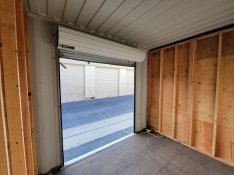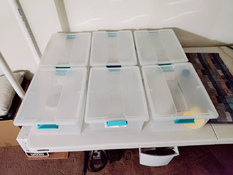Crickster
Member
- Joined
- Dec 3, 2015
- Messages
- 3
- Format
- 35mm
Hello all, I'm building a darkroom out of a storage unit that I'm renting (I got the OK from the land lady) and wanted some advice on how to go about doing so. I've taken darkroom courses in community college and tried a few times to make something but never really got anywhere. Now however I secured a location for a darkroom.
I already have everything I need material-wise. I will be using one of those cheap Home Depot Plastic stilt sinks.
As to why I'm doing this in a storage unit, I live in the SF Bay Area. My apartment is a glorified studio and space is at a premium. This storage unit is discounted since it's owned by a co-worker in my family business. Doubles as a place to store my prints. I've included a few pictures of the 8 x10 unit with the door open and closed. My friend is building a curtain out of black out cloth.
I've made cyanotypes and van dyke browns in a plastic garden shed when I lived at home. It was far from light proof but I had figured out how to get the lack of plumbing situation up and running. I know however that photo paper is completely different.
Note that I will not be developing film here, not yet anyways.
Have a few questions for the you experienced folks here.
I'm curious if its possible to "half wash" my prints without damaging them. What I mean is, drop the prints in a tray of water, let them sit, drive home at the end of the session, and rinse them in my shower?
Can I skirt around using stop bath for paper? Is straight water ok?
What advice can you give for not having plumbing?
I already have everything I need material-wise. I will be using one of those cheap Home Depot Plastic stilt sinks.
As to why I'm doing this in a storage unit, I live in the SF Bay Area. My apartment is a glorified studio and space is at a premium. This storage unit is discounted since it's owned by a co-worker in my family business. Doubles as a place to store my prints. I've included a few pictures of the 8 x10 unit with the door open and closed. My friend is building a curtain out of black out cloth.
I've made cyanotypes and van dyke browns in a plastic garden shed when I lived at home. It was far from light proof but I had figured out how to get the lack of plumbing situation up and running. I know however that photo paper is completely different.
Note that I will not be developing film here, not yet anyways.
Have a few questions for the you experienced folks here.
I'm curious if its possible to "half wash" my prints without damaging them. What I mean is, drop the prints in a tray of water, let them sit, drive home at the end of the session, and rinse them in my shower?
Can I skirt around using stop bath for paper? Is straight water ok?
What advice can you give for not having plumbing?













